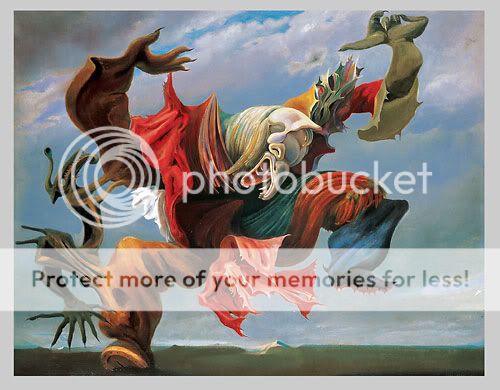Max Ernst’s Fire Side Angel

Max Ernst (French, born Germany, 1891–1976)
The Fireside Angel, 1937
Oil on canvas; 44 7/8 x 57 1/2 in. (114 x 146 cm)
Private collection
© 2004 Artists Rights Society (ARS), New York/ADAGP, Paris
Around our camp fire last night in Big Sur I remembered this favorite painting of mine and brought it up in conversation...
Loaded with symbols like doves and his mythical "LopLop" bird, Ernsts works vacillate between feelings of estrangement and enchantment. One notable exception on display, however, is Fireside Angel (1937), one of his few explicitly political canvases. Sub-titled The Triumph of Surrealism, it shows a bird-like monster blind with rage that serves to symbolize the wave of fascism gripping Europe.
"The Fireside Angel is a picture I painted after the defeat of the Republicans in Spain," Ernst once said about the work. "This is, of course, an ironical title for a kind of clumsy oaf which destroys everything that gets in the way. That was my impression in those days of the things that might happen in the world. And I was right."
“Fireside Angel,” painted in 1937 (during the Spanish Civil War) is a commentary on the hidden danger that lies underneath the veneer of Fascism. [Also, I think the stomping and this beast trying to escape from itself manifested as this grabbing monster coming out of its leg, might also perhaps be some kind of manifestation of a deep rooted guilt of Ernst’s; I just read that he abandoned, “rejected,” his first wife and child when he left Germany in 1922.]
“Ernst’s works took on a darker tone as he saw the signs of approaching world war. Forest imagery became more prominent in his work — forests, in Ernst’s words, “take over the sun.” Fascism was a plague spreading through Europe, and Ernst channeled his fear of this specter into 1937’s “Fireside Angel,” which depicts a raging, violent monster destructively plodding across an abstracted landscape. Ironically naming this frightening beast an “angel,” Ernst evokes the danger of the seemingly innocuous, referencing the surface appeal of fascism but underscoring the evil he perceived in its proliferation.” Review of "Max Ernst: A Retrospective" by Ryder Kessler
# Harvard Advocate
Monday, Feb 11, 2002 15:00 EST
Oldest living surrealist tells all
Dorothea Tanning, painter, sculptor, writer and wife of Max Ernst, counsels young artists: "Keep your eye on your inner world and keep away from ads, idiots and movie stars."
By John Glassie
Dorothea Tanning - Oldest living surrealist tells all
The Clash - Death is a Star
thanks for the vid Alexm799

0 Comments:
Post a Comment
Subscribe to Post Comments [Atom]
<< Home